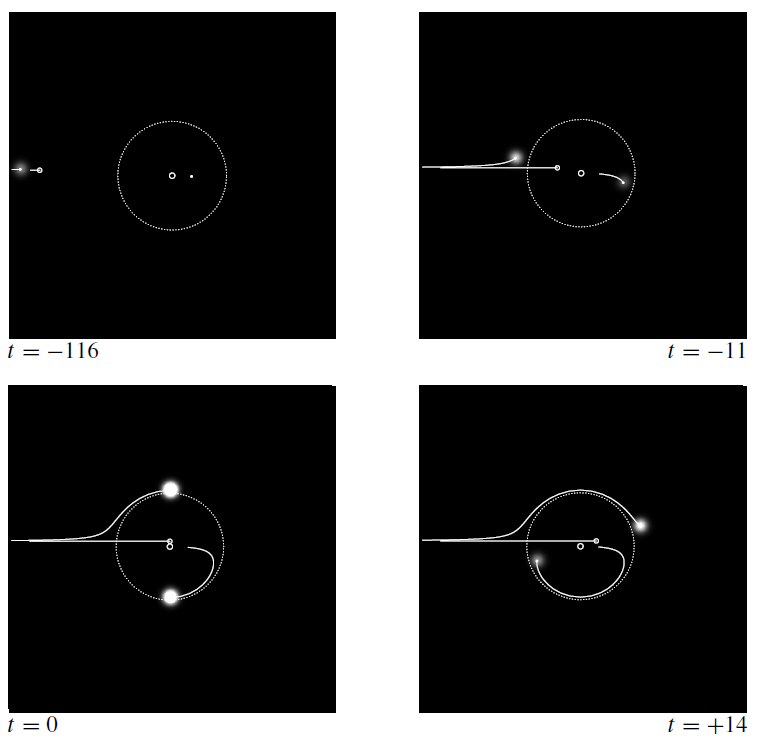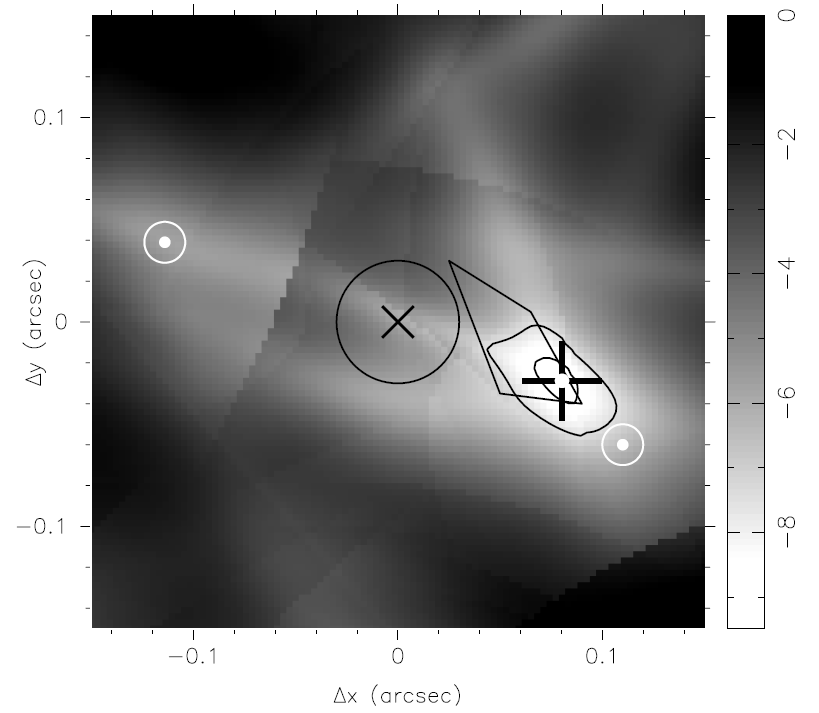
Pinpointing the MBH with lensed images
 المؤلف:
Heino Falcke and Friedrich W Hehl
المؤلف:
Heino Falcke and Friedrich W Hehl
 المصدر:
THE GALACTIC BLACK HOLE Lectures on General Relativity and Astrophysics
المصدر:
THE GALACTIC BLACK HOLE Lectures on General Relativity and Astrophysics
 الجزء والصفحة:
p 264
الجزء والصفحة:
p 264
 6-2-2017
6-2-2017
 2136
2136
Pinpointing the MBH with lensed images
Determining the exact position of the MBH on the IR grid is important because the radio source Sgr A*, which is associated with the MBH, has been detected to date only in one other band, the X-ray (Baganoff et al 2001). Currently, the IR position of the radio source Sgr A* is derived indirectly by aligning the radio and IR maps using four maser giants in the inner 15'', which are observed in both bands (Menten et al 1997). The exact IR position of the MBH is required, for example, for measuring the IR flux from the MBH, in order to constrain accretion models; for solving the stellar orbits around the MBH, in order to measure M● and R0 (Jaroszynski 1999, Salim and Gould 1999) and to search for general relativistic effects (Jaroszynski 1998, Fragile and Mathews 2000; Rubilar and Eckart 2001); and for detecting the fluctuations of the MBH away from the dynamical center of the stellar cluster, in order to study the stellar potential. Recent measurements of the acceleration vectors of three stars very near Sgr A* provide another way of locating the MBH (Ghez et al 2000). The IR/radio alignment and the center of acceleration are close, but do not overlap (figure 1.2), and neither coincide with an IR source. Gravitational lensing can provide a third, independent method for locating the MBH.
When the source, lens and observer move relative to each other, the positions, velocities and magnifications of the images will change with time (figure 1.1). In addition to the requirement that the two images and the lens lie on one line, imply that the measured angular positions of the two images θ1,2, their projected transverse velocities vt1,2 and radial velocities vr1,2 relative to the lens, and their measured fluxes F1,2, should obey the simple relation
 (1.1)
(1.1)
The constraints are based solely on observables, and so are independent of any assumptions about M●, R0 or the properties of the lensed background sources. The use of equation (1.1) does require knowledge of the exact position of the MBH relative to the stars, since this is needed for measuring the angular distances and for decomposing the radial and tangential components of the velocity. If the MBH position is known, equation (1.1) can be used to search in astrometric measurements of positions, fluxes and velocities for pairs of lensed images around the MBH. Equation (1.1) can also be used to find the position of the MBH on the IR grid, since the MBH lies on the line connecting the two images, and so the intersection of these lines pinpoints its position. This can be done statistically, by enumerating over a grid of trial positions for the MBH, and choosing as the most likely one that which maximizes the number of lensed image pairs.
Figure 1.2 shows the results from such a joint statistical search for the MBH and for a signature of lensing (Alexander 2001). The most likely position of the MBH coincides with the center of acceleration. The random probability for such a likelihood extremum is 0.01. The random probability for such an extremum to fall in either the 1σ error range of IR/radio alignment or that of the center of acceleration is 5 × 10−4.
The search for the MBH yields also a list of candidate lensed image pairs. The definitive test of lensing is to compare their spectra, which should be identical up to differences due to non-uniform extinction. Unfortunately, spectra for the fainter secondary images are unavailable at this time. Once M●, R0 and the dust distribution in the Galaxy are assumed, it is possible to derive, albeit with very large uncertainty, the luminosity and distance of the candidate sources. The sources of the two most likely lensed image pair candidates are luminous

Figure 1.1. A sequence of snapshots simulating the observation of lensing of a background point source by the MBH. Time is in arbitrary units. The background source, which is not observed directly (open circle with straight line tracking the source trajectory) moves in projection from left to right behind the MBH (open circle at center) with an impact parameter of 0.1θE. The two images (light points with curved lines tracking the image trajectories) move in tandem clockwise about the Einstein ring (large dotted circle). The strongly magnified image (top) is always outside the Einstein ring and is always brighter than the source. The weakly magnified image (bottom) is always inside the Einstein ring and can be strongly demagnified (panels a, b). At peak magnification (panel c) the two images are of comparable brightness.
supergiants, a blue supergiant a few kpc behind the Galactic Center and a red supergiant at the far edge of the Galaxy.
This statistical result, while intriguing, requires additional confirmation. Simple models of the distribution of light and dust in the Galaxy predict that the chances of finding luminous supergiants right behind the MBH are very small,

Figure 1.2. Pinpointing the MBH on the IR grid with gravitationally lensed stars (Alexander 2001). A gray scale plot of the logarithm of the likelihood of the MBH position (shifted to 0 at the maximum), for 116 stars from the astrometric compilation by Genzel et al (2000), as a function of the shift in the astrometric grid over the central 0.3'' × 0.3'' search field. The cross in the center is the origin according to the IR/radio alignment with its 1σ error circle (Menten et al 1997). The polygon is the ∼1σ error region for the center of acceleration (Ghez et al 2000). The circles are the observed IR sources with their 10 mas error circles. The most likely position of the MBH is indicated by a plus sign with 1σ and 2σ confidence level contours. (Reprinted with permission from The Astrophysical Journal.)
and the statistical analysis depends sensitively on the quality of the data and its error properties. Whether or not this particular result survives further scrutiny, it illustrates the potential of gravitational lensing as a tool for the study of the Galactic Center. This statistical method for locating the MBH by gravitational lensing should be re-applied whenever deeper astrometric data become available.
 الاكثر قراءة في مواضيع عامة في علم الفلك
الاكثر قراءة في مواضيع عامة في علم الفلك
 اخر الاخبار
اخر الاخبار
اخبار العتبة العباسية المقدسة


